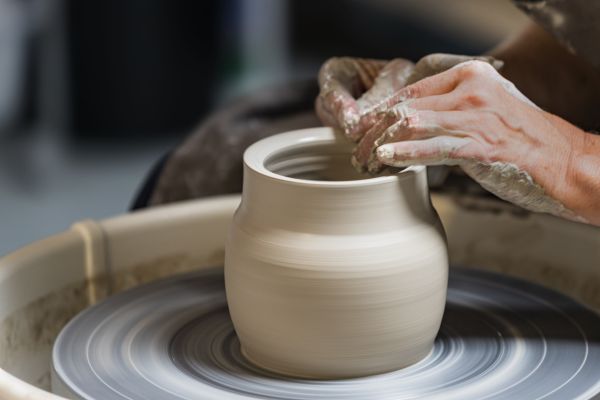Pottery is one of the oldest and most enduring forms of human craftsmanship, dating back thousands of years. It has played a significant role in the development of ancient civilizations, serving as a testament to their cultural, artistic, and technological achievements. In this article, we will embark on a journey through time to explore the rich history of pottery in various ancient civilizations. From the earliest pottery-making techniques to the intricate designs and innovative methods employed by these societies, we will discover the profound influence pottery had on their cultures and legacies.
1: The Origins of Pottery-Making
1.1 The Earliest Discoveries: Uncovering the Origins of Pottery
Archaeological finds have revealed pottery fragments dating back to prehistoric times, offering glimpses into the earliest forms of pottery-making. These early pieces were often hand-built using simple techniques, such as pinching and coiling, and fired in open fires or rudimentary kilns.
1.2 The Neolithic Revolution: Pottery as a Cultural Shift
With the advent of agriculture and settled communities during the Neolithic period, pottery production witnessed a significant shift. Pottery became more refined and complex, with the introduction of wheel-throwing techniques and the use of kilns for controlled firing. This marked a transformative moment in human history, as pottery played a crucial role in food storage, trade, and cultural exchange.
1.3 From Sun-Dried Clay to Kiln-Fired Pottery: Technological Innovations
As civilizations advanced, so did pottery-making techniques. The development of kilns allowed potters to achieve higher firing temperatures, resulting in stronger and more durable vessels. Glazes, made from mineral-based compounds, were also introduced, adding both functionality and decorative elements to pottery.
2: Mesopotamian Pottery: The Cradle of Civilization
2.1 The Birthplace of Pottery: Mesopotamian Innovations
Mesopotamia, known as the “Cradle of Civilization,” witnessed significant innovations in pottery-making. Early Mesopotamian potters utilized simple hand-building techniques, creating utilitarian vessels for storage and cooking. Over time, they refined their skills, introducing wheel-throwing and mold-making techniques to produce more intricate and elaborate pottery.
2.2 Artistry and Symbolism: Pottery in Ancient Mesopotamian Society
Mesopotamian pottery was not just functional; it also served as a means of artistic expression and cultural representation. Intricate designs and motifs, often depicting mythological scenes and religious symbolism, adorned pottery vessels. Cuneiform script was sometimes incised onto pottery, documenting important events and acts of governance.
2.3 The Legacy of Mesopotamian Pottery: Influence on Later Civilizations
The innovations of Mesopotamian potters had a lasting impact on pottery traditions that followed. Techniques such as wheel-throwing and kiln firing spread to neighboring regions, influencing the pottery of ancient Egypt, Greece, and beyond. Mesopotamian pottery remains a valuable archaeological and historical resource, providing insights into the cultural and technological achievements of this ancient civilization.
3: Egyptian Pottery: Artistic Expressions of the Nile
3.1 Mastery of Clay and Color: Egyptian Pottery Techniques
Egyptian potters were highly skilled in clay manipulation, using hand-building and wheel-throwing techniques to create a variety of vessel shapes. They also developed innovative methods of firing, utilizing kilns and specialized clay bodies to achieve desired results. Egyptian pottery was characterized by meticulous attention to detail and a rich palette of vibrant colors.
3.2 Symbolism and Mythology: Pottery in Ancient Egyptian Culture
Pottery in ancient Egypt was closely intertwined with their religious beliefs and mythology. Decorative motifs often depicted gods, goddesses, and mythological scenes, embodying their spiritual and cosmological beliefs. Hieroglyphic inscriptions and symbols adorned pottery, serving as conduits for communication with the divine.
3.3 Funerary Pottery: The Role of Pottery in Egyptian Burial Customs
Egyptians placed great importance on the afterlife, and pottery played a significant role in their funerary practices. Elaborate ceramic vessels, known as canopic jars, were created to hold the organs of the deceased during mummification. These vessels, along with other funerary pottery, symbolized the transition from earthly life to the realm of the dead.
4: Greek Pottery: Artistic Excellence and Mythological Tales
4.1 Aesthetic Beauty and Technical Mastery: Greek Pottery Techniques
Greek pottery is renowned for its exceptional craftsmanship and technical skill. Greek potters mastered the art of wheel-throwing, producing symmetrical and balanced vessels. They also developed innovative methods of surface decoration, such as black-figure and red-figure painting, creating intricate and visually stunning designs.
4.2 Mythology and Narrative: Pottery as Visual Storytelling
Greek pottery served as a medium for storytelling, with scenes from mythology, historical events, and everyday life depicted on its surfaces. These painted narratives not only entertained but also provided insights into Greek culture, religious beliefs, and social customs. Vase shapes and sizes were carefully chosen to complement the subject matter and enhance the storytelling aspect.
4.3 Red-Figure and Black-Figure Masterpieces: Styles and Evolution
Greek pottery is particularly renowned for its black-figure and red-figure styles. In the black-figure technique, figures were painted in black against a reddish background, while in the red-figure technique, the background was painted black, allowing for more detailed and nuanced depictions. These styles evolved over time, showcasing the artistic progression and experimentation of Greek potters.
5: Roman Pottery: Utilitarian and Decorative Delights
5.1 From Utility to Artistry: Roman Pottery Techniques
Roman pottery encompassed a wide range of utilitarian and decorative vessels. Roman potters excelled in both wheel-throwing and mold-making techniques, producing functional items such as amphorae, bowls, and plates. They also created ornamental pieces adorned with intricate designs and relief work.
5.2 Terra Sigillata: The Finest Roman Pottery
Terra Sigillata, also known as Samian ware, was a highly prized type of Roman pottery. It featured a smooth, polished surface and intricate relief decorations. Terra Sigillata vessels were often used for fine dining, showcasing the artistic and technical prowess of Roman potters.
5.3 Influence and Legacy: Roman Pottery Beyond the Empire
The Roman Empire’s vast reach and cultural influence spread Roman pottery techniques and designs throughout its territories. The use of Roman pottery vessels, particularly amphorae, for trade and transportation played a crucial role in the dissemination of Roman pottery traditions to distant regions. Roman pottery remains a significant archaeological and historical resource, shedding light on ancient trade networks and cultural interactions.
6: Persian Pottery: Splendor of the East
6.1 The Artistry of Persian Pottery: Techniques and Influences
Persian pottery showcased a fusion of cultural influences, incorporating techniques from neighboring regions such as Mesopotamia, Egypt, and Greece. Persian potters employed wheel-throwing and mold-making techniques, often producing vessels with distinctive shapes and intricate surface decorations.
6.2 Persian Pottery and Cultural Identity
Pottery in ancient Persia played a significant role in expressing cultural identity and religious beliefs. Many vessels were adorned with intricate patterns, calligraphy, and symbolic motifs, reflecting the rich tapestry of Persian culture. Persian pottery was also influenced by Zoroastrianism, the predominant religion of the region, with depictions of fire and divine beings frequently featured.
6.3 Innovations and Exquisite Designs in Persian Pottery
Persian potters were known for their innovative use of glazes and techniques such as lusterware, which created a metallic sheen on the surface of the vessels. They also developed unique forms, such as the iconic Persian turquoise glazed tiles used in architectural ornamentation. Persian pottery exemplified the refined aesthetic sensibilities and technical expertise of the civilization.
7: Chinese Pottery: The Mastery of Porcelain
7.1 Porcelain as a Chinese Invention: Techniques and Secrets
Chinese pottery is synonymous with the mastery of porcelain, a material renowned for its translucency, durability, and whiteness. Chinese potters perfected the art of porcelain production, combining kaolin clay and feldspar in precise proportions and firing at high temperatures in kilns.
7.2 The Symbolism and Spiritual Significance of Chinese Pottery
Chinese pottery often featured symbolic motifs deeply rooted in Chinese culture and philosophy. Dragons, phoenixes, and other mythical creatures adorned vessels, representing power, prosperity, and auspiciousness. The use of pottery in religious and ceremonial contexts further emphasized its spiritual significance.
7.3 The Intricate Art of Blue and White Porcelain
Blue and white porcelain is a hallmark of Chinese pottery, characterized by intricate blue patterns on a white background. This technique, first developed during the Yuan Dynasty, reached its zenith during the Ming and Qing Dynasties. Blue and white porcelain vessels became highly sought after and were exported to various parts of the world, showcasing the global impact of Chinese pottery.
Conclusion
The rich history of pottery in ancient civilizations reveals the profound impact of this craft on culture, artistry, and technological advancements. From the earliest pottery-making techniques of the Neolithic period to the exquisite masterpieces created by ancient civilizations, pottery has served as a vessel of artistic expression, cultural preservation, and utilitarian necessity.
The techniques, styles, and innovations developed by ancient potters have left an indelible mark on the world of pottery. Their legacy continues to inspire and influence contemporary artists and craftsmen, bridging the gap between ancient traditions and modern creativity.
As we explore the diverse pottery traditions of ancient civilizations, we gain a deeper appreciation for the skill, creativity, and cultural significance embedded in each vessel. The enduring beauty and historical value of ancient pottery serve as a testament to the rich tapestry of human history, connecting us to the past and inspiring future generations.
So, the next time you encounter a beautifully crafted pottery piece, take a moment to admire the craftsmanship and artistic ingenuity that has transcended time. Let the rich history of pottery in ancient civilizations inspire your own creative pursuits and deepen your understanding of the profound impact of this ancient craft.



